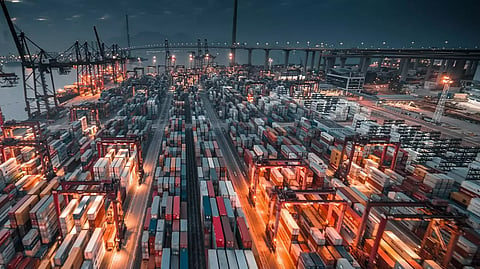3 Ways to Fix Global Trade and Drive Economic Recovery
By Sultan Ahmed Bin Sulayem
After more than two years of a devastating pandemic and the global economic shockwaves triggered by the return of war to Europe, the growth prospects of the world’s economy have become uncertain once again.
The International Monetary Fund predicts that global growth will slow sharply from an estimated 6.1% in 2021 to 3.6% this year and next.
Global trade disruptions
It doesn’t help that many of the world’s supply chains continue to be disrupted. While a lot of repair work was underway, war, sanctions, and a new round of COVID-19 lockdowns in China have delivered more setbacks.
The result is much more than the inconvenience of longer waiting times for a new car or home appliance. We are facing the genuine prospect that the economic setback will continue to have the most impact on the most vulnerable societies.
This development is especially disappointing given that trade and business optimism had grown around the world as economies were showing resilience in the face of the pandemic.
DP World's Trade in Transition report, produced in partnership with Economist Impact, shows that more than two-thirds of business leaders saw exports grow by up to 50% between 2020 and 2021.
I found this data truly encouraging because we know that global trade has been a critical driver of the dramatic decline in poverty worldwide. According to the World Bank, trade lifted nearly 1 billion people out of extreme poverty in the past 30 years alone.
The pandemic, however, has now pushed millions back to the brink of extreme poverty. That’s why we cannot – and must not – afford another economic shock that harms those who rely most on the benefits of trade.
Public and private sector leaders and entities must urgently work together to safeguard trade to protect the global economy and the world’s poorest. This starts with fixing the systemic issues that continue to affect the world’s fragile supply chains.
Take container ships: a fifth of them are currently stuck in congested ports due to ongoing lockdowns. Meanwhile, new shipping capacity has yet to be built, even while there is an imbalance between supply and demand in several sectors.
The good news is that we already have many of the solutions and tools required to make supply chains more resilient; we can put these into action, provided the public and private sectors work closely together.
We must re-evaluate traditional approaches to supply chain management and redesign existing networks to make them more resilient by design. The current single-minded focus on cost strips out the prioritization of resilience and agility needed to keep trade flowing.
Fixing global trade
I believe that we can fix global trade if we focus on these three areas:
1. Anticipate risk better
The last few years are a painful reminder that events once considered remote possibilities can cause massive disruption to global supply chains.
Even more localized events like the incident in the Suez Canal upended global trade as we know it. However, we have the cross-sector expertise to anticipate and mitigate such risks.
Collaborating to share data and highlight areas of risk must be a priority.
What if we got better at forecasting when major crises might erupt and how they might play out? Industry-wide, we can apply our expertise to consider risk scenarios and solutions to ensure that we are prepared for a wider range of risks.
2. Embrace digitalization
Fixing global supply chains requires trust and transparency; digital technologies and platforms offer both the ability and opportunity to share real-time data.
Whether that’s blockchain solutions that boost information security or digital portals that enhance freight visibility, we see a proliferation in technology that can make supply chains more transparent and better understood.
Businesses must embrace the opportunities offered by technology to streamline processes and boost visibility throughout the supply chain.
3. Make trade possible for everyone
Boosting trade is one of the most powerful tools to lift people out of poverty. As the Trade in Transition report shows, the post-pandemic economic recovery was uneven even before the war in Ukraine.
Initiatives like the World Logistics Passport can help governments collaborate more closely on trade and kickstart their economies by making it easier for exporters and importers to reap the benefits of international trade.
By working together across borders towards a common goal, governments and businesses can build a more robust global trading community that is both agile and resilient.
Now is the time to invest in defending logistics networks against risk, expand digitalization and provide the incentives that make global trade work for everyone.
Taken together, these initiatives will ensure that we do not simply react to shocks but are well prepared to navigate them effectively.
With the World Economic Forum’s upcoming Annual Meeting 2022 in Davos, we have a chance to strengthen global trade for good. We should use the annual meeting as an incubator for change that was much needed even before our world entered the first lockdowns.
Our world cannot wait for the next economic shock; our already fragile supply chains would falter, economies, businesses, and consumers would struggle, and the impact on the world’s poorest is not something anyone would like to imagine.
That is why we must act now. That is why we must transform trade together.


